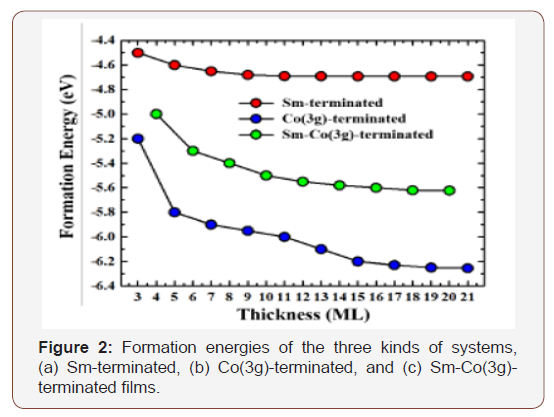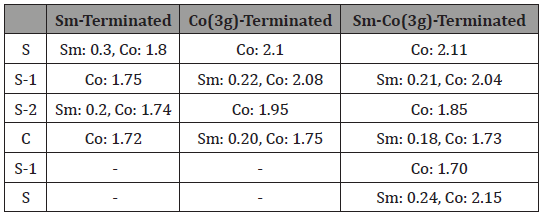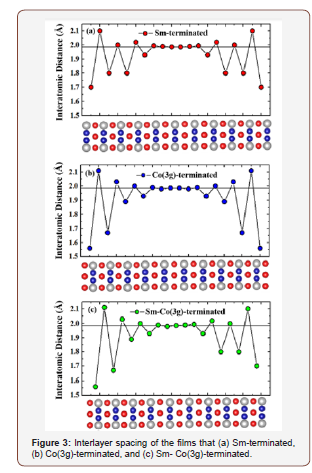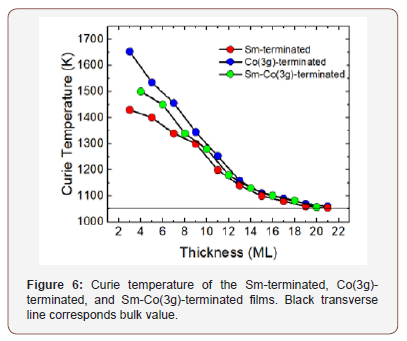 Research Article
Research Article
Surface Termination and Thickness Dependent Magnetic Properties of SmCo5 Film
Eunsung Jekal, Department of Materials, ETH Zurich, 8093 Zurich, Switzerland.
Received Date: November 23, 2019; Published Date: December 06, 2019
Abstract
We investigated the surface termination and film thickness dependent magnetic properties of SmCo5(001) thin films. For this study, three different terminations, namely Sm-termination, Co(3g)-termination, and Sm-Co(2c)-termination with thicknesses varying from 3 to 21 mono-layers (MLs), are considered. Compared with magnetocrystalline anisotropy (MCA) of bulk SmCo5 of ∼9 meV/f.u., our results revealed that the Co(3g)- terminated thin films less than 7 MLs have extremely strong perpendicular MCA of 21 meV/ f.u. where f.u. is the area of a two-dimensional unit cell. Furthermore, it reveals high Curie temperature compared to the Sm-terminated and Sm-Co(2c) terminated case.
Introduction
Films with large magnetic anisotropy have drawn intensive attention in the field of magnetic recording devices. A thin film with the perpendicular magnetization to the surface is estimated as a promising candidate for ultra-high-density magnetic recording media [1,2].
The SmCo5 alloy, which is a well-known permanent magnet material, exhibits a strong magnetocrystalline
anisotropy (MCA) with a magnetic anisotropy constant of 2.0108 erg/cm3. Besides, its high Curie temperature (Tc) and coercivity are another strong feature to use it as a permanent magnet for high temperature applications. Thus, SmCo5 is expected to be highly useful for a magnetic recording or thermally assisted magnetic recording (TAMR) devices.
Recently, it has been investigated that SmCo5 thin films exhibit perpendicular magnetic anisotropy. Chen et al reported that a SmCo film sputter-deposited at a high Ar pressure and postannealed at a high temperature showed perpendicular magnetic anisotropy. However, this SmCo film was amorphous and did not have the structure of the SmCo5 phase. Neu et al asserted that pulse laser deposition of the SmCo5 thin film in an Ar atmosphere led to perpendicular magnetic anisotropy in the film [3-7].
While the intrinsic properties of hard and soft magnetic phases play dominant roles, optimization of surface and interface properties are also important, to achieve the best performance in such nanocomposite permanent magnets. For example, interface morphology needs to be elucidated to optimize the good exchange coupling between the soft and hard phases. Micromagnetic simulations have suggested that magnetically graded interface, whose magnetic properties gradually change over a distance ≈10 nm, is more effective than a sharp interface, in order to increase the nucleation field in the soft phase and decrease the switching barrier of the hard phases. However, most of these studies have been performed without accounting the contribution of the nature of surface termination of SmCo5 phase at nanoscale. In fact, understanding the surface termination of SmCo5 phase at nanoscale would further allow the tailoring of the composition of soft phase. Considering the above, in the present study, the binding energy, total magnetic moment and spin polarization of various surface terminated (001) SmCo5 slabs are calculated using first principles density functional calculations to get more insight on SmCo5 layered structure.
Computational Method
First principles calculations are implemented using VASP [8] to study the structural stability, electronic and magnetic properties of (001) SmCo5 surface slabs with three different surface terminations. Sm and Co atoms are described by projector augmented wave functional formalism and the exchange correlation is corrected by on-site Coulombic interaction term included generalized gradient approximations (GGA+U) [9]. Throughout the calculations, U=6.2 eV and exchange parameter J=0.7 eV is used for Sm atom which is adopted from the earlier work.

and

Here, ϵf and nf represent energy level and occupancy of f electrons of Sm, respectively, and the majority (minority) spin is denoted as ↑ (↓). Kinetic cut-of energy of 600 eV for plane wave basis set is used in our calculations. Brillouin zone of periodic cell is sampled by 8×8×1 k-mesh for surface slabs.
Different surface terminated surface slabs shown in Figure 1 are constructed using experimental lattice constants of a = b = 4.996 Å and c = 3.972 Å of SmCo5 compound. Both ionic and electronic relaxations are alternatively performed until the energy difference of two successive ionic steps and the force constant of ions are converged below 0.001 meV. For converged structure, density of states is deduced by employing the no self-consistent calculations in which 14×14×1 k-mesh is used.

The EMCA is calculated by force theory and is defined as the total energy difference for alignment of magnetization along in-plane and out-of-plane : K = E[100]-E[001], where E[100] and E[001] represent total energies with the magnetization aligned along the [100] and [001] direction, respectively.
In details, The EMCA is calculated in three steps. First, a collinear self-consistent calculation without spin-orbit coupling (SOC) is performed. Then, a global rotation is applied on the density matrix to consider the magnetization alignment along different directions of [001] and [100] to calculate E[001] and E[100], respectively. Finally, non-collinear and non-self-consistent calculation with SOC is performed.
Results and Discussions
Structure and magnetic moment

For comparison with the film thickness dependence of
adsorption, we calculate the behavior of surface energies for
three types of films. The formation energy of a film thickness L is
calculated as  where EL is the total energy of the
slab, NL is the total number of atoms in the supercell, A is the area
of the bottom or top face of the supercell, and σbulk is the energy
per atom in the bulk crystal. Regardless of film thickness, film with
surface of Co(3g) shows the most stable energy. On the other hands,
Sm-terminated films exhibit unstable behavior. However, all three
kinds of films are getting stable when the film thickness is getting
thicker (Figure 2).
where EL is the total energy of the
slab, NL is the total number of atoms in the supercell, A is the area
of the bottom or top face of the supercell, and σbulk is the energy
per atom in the bulk crystal. Regardless of film thickness, film with
surface of Co(3g) shows the most stable energy. On the other hands,
Sm-terminated films exhibit unstable behavior. However, all three
kinds of films are getting stable when the film thickness is getting
thicker (Figure 2).
Further, we also calculate interlayer spacing. According to a
noninteracting electron-gas model (EGM), if the interlayer spacing
d of a metal film is related to the half fermi wavelength via λF/2.
When mλF/2 is sufficiently close but not exactly equal to jd, then
oscillations with a period of jd will be modulated into a beating
pattern with a beat period of ∧ j, where,  Thus, the
interlayer spacing oscillates as shown in Figure 3.
Thus, the
interlayer spacing oscillates as shown in Figure 3.
In Table 1, we present magnetic moment.
Table 1: Calculated atomic magnetic moment (𝜇B) of 7-ML asymmetric films 6-ML asymmetric film.


The magnetic moments of Sm and Co atoms of 7, and 6 ML films in both the terminations are presented in Table 1. The surface and the nth layer below the surface are denoted as (S) and (S-n). Surface Sm and Co atom of Sm-terminated film exhibits 0.3 μB and 1.8 μB, respectively. In comparison with the bulk magnetic moments of 0.2 μB and 1.6 μB, the surface layers have the slightly value than that of the bulk, unlike other surfaces of magnetic elements Fe, Co, and Ni, where the moments are strongly enhanced. And it is closer to the center, magnetic moment has almost same value with bulk.
Magnetocrystalline anisotropy

A plot of EMCA as a function of the film thickness and the termination is shown in Figure 4. Thinner films improve EMCA while thicker films decrease the value of EMCA. It is remarkable more than two times greater EMCA is obtained when 3-ML films compared to that of bulk or thicker films of 21-ML case. Among three cases of Sm-terminated, Co(3g)-terminated and Sm-Co(3g) terminated films, Co(3g)-terminated has the biggest EMCE while Sm-terminated films has the lowest EMCA regardless of the film thickness.
Since the lowest-order contribution of HSOC toward the total energy is simply given as within the second-order perturbation theory, the EMCA is determined as

within the second-order perturbation theory, the EMCA is determined as

where ξ is the spin-orbit coupling constant and ↑(↓) represents majority(minority) spin. o(u) and 𝜀o(u) represent eigenstate and eigenvalue of occupied (unoccupied) state, respectively. For contributions from the d-orbitals, the matrix elements of the Lx and Lz operators can be expressed through magnetic quantum number, m. In case the occupied and the unoccupied states have different spin directions, mo-mu=±1 and mo-mu=±0 contribute to perpendicular and in-plane MCA, respectively, while mo-mu=±2 is treated as zero matrix element.
Calculations with HSOC from different atoms of Co(2c), Co(3g) and Sm confirmed that Co(2c) atom mainly contributes to the EMCA of SmCo5.
Determining the perpendicular MCA is manifested in the DOS:
conspicuously sharp peaks of ↓ and ↑, ↓ are placed just above
the Fermi level in unoccupied state. This peak contributes to
perpendicular MCA through the
Especially in the range near the Fermi level, we can see that the ↓ is getting sharper and larger in order of Sm-terminate, Sm- Co(3g)-terminate and Co(3g) terminated.
Exchange interaction and curie temperature
Since the de Gennes factor of Sm is relatively small, the Curie temperature is mainly determined by the Co atoms. Therefore, we focused on the Co-Co exchange interactions. To understand the role of surface termination and thickness in the exchange interaction.
In-plane couplings of J2c-2c and J3g-3g and J2c-3g show biggest value. The effective exchange coupling parameters Jeff, which is the sum of the exchange coupling constants within a sphere with a given cutof radius (R), are also calculated. Here, we used five times lattice constant as a cut-of radius (R=5a). The overall effective exchange coupling parameters are derived in the framework of the multisublattice mean-field approximation. For the Co(3g)-terminated films, the strongest Jeff exhibit in the Co(3g) terminated film (Figure 5).

The corresponding Curie temperatures are also derived from the calculated exchange parameters based on the mean- field approximation. As shown in Figure 6, for Co(3g)-termnated film case, Tc increases to 1650 K while bulk value is 1020. This feature of Tc results from the surface termination dependence of the effective exchange parameters.

The results indicate that the Co(3g)-terminated films improve magnetization, MCA energy and Curie temperature compared to the bulk SmCo5 and films with another surface. It is expected that multilayers films of SmCo5 they could be good candidates for high temperature magnetic applications.
Conclusion
Using density functional theory and mean-field theory calculations, we investigated the film thickness and the surface termination effect on magnetic properties of SmCo5 films. We found Co(3g) terminated film shows the lowest formation that it is most stable among others. Furthermore Co(3g) terminated film improves magnetization, EMCA and Tc which are key properties for spintronics or big motor. In comparison with an equilibrium state of bulk SmCo5, about two times larger EMCA and 600 K higher Tc is observed in Co(3g) terminated films.
Acknowledgment
Eunsung Jekal thanks scientific computing center in ETH Zurich.
Conflict of Interest
No conflict of interest.
References
- P Saravanan, S Boominathasellarajan, Bartłomiej Sobelb, Stanisław Wacławekc, VTP Vinod, et al. (2019) Interfacial layer formation during high-temperature deposition of Sm-Co magnetic thin films on Si (100) substrates. Intermetallics 106: 36-37.
- G Han, Ke Wang, KE Elkins, Z Qiu, RB Timmons, et al. (2019) Cold plasma reduction of surface carbon on SmCo5 nano-flakes prepared by surfactant-assisted ball-milling. Journal of Magnetism and Magnetic Materials 471: 250-254.
- Dong Y, Zhang T , Xia Z , Wang H , Ma Z, et al. (2019) Dispersible SmCo5 nanoparticles with huge coercivity. Nanoscale 11(36): 16962-16967.
- Jekal S (2019) Dependence of Atomic Thickness on Interfacial Conditions and Magnetocrystalline Anisotropy in SmCo5/Sm2Co17 Multilayer Materials 12: 56.
- Jekal S (2019) Exchange Interactions and Curie Temperature of Ce-Substituted SmCo5. Condensed Matter 4(1): 11.
- SY Jekal, J Loffler, M Charilaou (2019) Bulletin of the American Physical Society.
- SY Jekal, J Loffler, M Charilaou (2018) Pushing the limits of magnetic anisotropy in the Sm-Co system. Condensed Matter, arXiv:1807.09257.
- G Kresse, J Furthmüller (1996) Efficient iterative schemes for ab initio total-energy calculations using a plane-wave basis set. Phys Rev B 54: 1169.
- A Jain, G Hautier, SP Ong, CJ Moore, CC Fischer, et al. (2011) Formation enthalpies by mixing GGA and GGA +U calculations. Physical Review B 84: 045115.
-
Eunsung Jekal. Surface Termination and Thickness Dependent Magnetic Properties of SmCo5 Film. Mod Concept Material Sci. 2(3): 2019. MCMS.MS.ID.000538.
-
Surface termination, SmCo5, Thin film, Curie temperature, Film thickness, Magnetic anisotropy, Sm-terminated film
-

This work is licensed under a Creative Commons Attribution-NonCommercial 4.0 International License.






